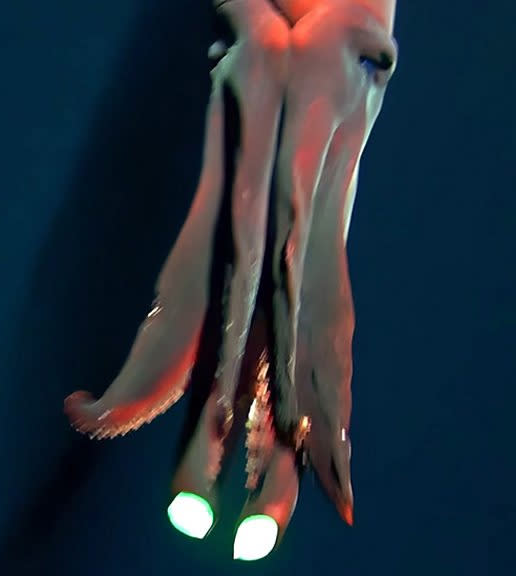One of the world’s most elusive squid species put on a blinding bioluminescent display as it attacked an underwater camera in the deep sea, exceptionally rare new footage reveals.
Researchers from the Minderoo Foundation and the University of Western Australia (UWA) Deep Sea Research Center captured the rare encounter, which occurred around 3,281 feet (1,000 meters) below the Pacific Ocean’s surface, using a free-falling baited camera dropped into the sea near the Samoan Passage — an area of deep water flow north of Samoa.
The team was on a research cruise documenting the diversity of the deepest part of the ocean — the hadal zone — when they spotted the rare creature.
The animal in the video is a Dana octopus squid (Taningia danae), a member of the family Octopoteuthidae that feeds on pelagic fish, crustaceans and other squid species.
Squid species within the Octopoteuthidae family have eight arms which is why they are called octopus squid. As juveniles they have two long, trailing tentacles in addition to their arms, but these are lost as the squid matures.
Members of this species are known for their colossal size. The longest individual ever reported was a 7.5-foot-long (2.3 m) female, according to a 2003 study. The individual in the new video is around 2.5 feet (75 centimeters) long, according to a statement from UWA.
In the footage, the squid suddenly appears from the darkness and darts toward the camera, engulfing it with its arms before making a quick getaway. Moments before latching onto the camera, the squid shows off a pair of bright, light-emitting organs, known as photophores, at the tips of two of its arms.
This species’ photophores — which emit bursts of light as a result of a chemical reaction — are the largest of their kind in the animal kingdom, researchers wrote in the statement. But scientists have rarely seen the squids’ biological lights used in action.
“As we were reviewing the footage, we realized we had captured something very rare,” Heather Stewart, a marine geologist and affiliate researcher at UWA, said in the statement. “I think we were very lucky to have witnessed this.”
Related: Black-eyed squid dragging thousands of eggs like a cape captured in video off Costa Rica
Researchers believe the squids’ photophores help them stun prey in the dark waters of the deep sea and possibly communicate with other individuals of the same species. These squid can change the pattern of flashes by controlling the eyelid-like membranes that cover their light-producing organs, according to a 2017 study.

In the video, the squid “descended on our camera assuming it was prey, and tried to startle it with its huge bioluminescent headlights,” Stewart said.
RELATED STORIES
—Diver captures stunning photos of rare 8-foot giant squid
—Watch elusive, sucker-less squid in rare footage captured off the Galapagos
—Adorable, newfound pygmy squid species named after Japanese forest fairies
Overall, researchers know very little about this species’ behavior because T. danae are rarely seen alive.
“Many records of this species are from strandings, accidental bycatch or from the stomach contents of whales,” Alan Jamieson, director of UWA’s Deep Sea Research Centre, said in the statement.
T. danae were only spotted alive for the first time around 19 years ago, by researchers using a similar camera system, according to a study published in 2007. And these squid have been seen alive only a handful of times since.
“The rarity of live observations of these amazing animals makes every encounter valuable in gathering information on geographic locations, depth, and behavior,” Jamieson said in the statement.
Source Agencies

